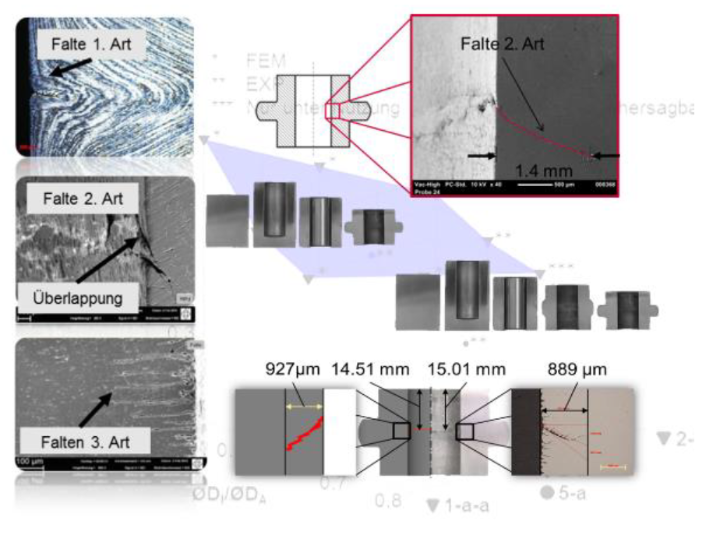Today's functionalities of modern FE codes for hot and cold forging are almost indispensable in the processing of current research questions in forging. The possibilities offered by today's time integration methods, the design of material and tribology models and the freedom of numerical calculation parameters contribute significantly to the success of such research work. The Institute of Forming Technology has many years of simulation and modeling expertise in the application of the FE codes DEFORM 2D/3D, QFORM, ABAQUS, ANSYS in conjunction with powerful CAD programs for the reliable design of established and innovative forming processes in massive forming. In addition to new process kinematics, the working group also deals with research questions in the fields of sensitivity analysis, robustness evaluation and multi-criteria optimization.
Wrinkles of the 1st, 2nd and 3rd type (left, from top to bottom), experimentally investigated process routes (center), validation of the wrinkle criterion of the 2nd type (bottom, right) and SEM image of the wrinkle of the 2nd type (top)
Lightweight components manufactured by cold forging, usually rotationally symmetrical, usually have a central hole. Cost- and resource-efficient production of these hollow extruded parts is only possible by using hollow semi-finished products at the beginning of the process chain, which can also be produced by forming processes. It is known from research projects at the Institute of Forming Technology that three different types of folds can occur in the equatorial plane of the upset collar when upsetting the collar of hollow extruded parts. A previously unsolved problem is the predictive, temporally and spatially correct prediction of the second type of fold using the finite element method. A study for the German Cold Forging Group (GCFG) focuses on the experimental investigation of the influencing variables on wrinkle formation of the 2nd kind and the empirical description of the influencing variables. Numerous numerical and experimental investigations have shown the influencing variables on the three wrinkle formation mechanisms and made it possible to describe the wrinkle of the 2nd kind using an empirical wrinkle criterion.


